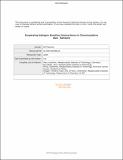Employing Halogen Bonding Interactions in Chemiresistive Gas Sensors
Author(s)
Weis, Jonathan Garrett; Ravnsbaek, Jens Bomholdt; Mirica, Katherine; Swager, Timothy M
Downloads1-ln1991529-482995468-1939656818Hwf410674913IdV-4764312711991529PDF_HI0001.pdf (528.3Kb)
PUBLISHER_POLICY
Publisher Policy
Article is made available in accordance with the publisher's policy and may be subject to US copyright law. Please refer to the publisher's site for terms of use.
Terms of use
Metadata
Show full item recordAbstract
This paper reports the use of halogen bonding interactions for gas-phase detection of pyridine in SWCNT-based chemiresistive sensors with sub-ppm theoretical detection limits. The chemiresistors are prepared by solvent-free ball-milling of single-walled carbon nanotubes (SWCNTs) and aryl halide-based selectors, compression into a pellet, and subsequent mechanical abrasion between gold electrodes on paper. The sensing responses reflect halogen bonding trends, with few exceptions. The predominant signal transduction mechanism is likely attributed to swelling of the insulating haloarene matrix.
Date issued
2015-11Department
Massachusetts Institute of Technology. Department of ChemistryJournal
ACS Sensors
Publisher
American Chemical Society (ACS)
Citation
Weis, Jonathan G. et al. “Employing Halogen Bonding Interactions in Chemiresistive Gas Sensors.” ACS Sensors 1.2 (2016): 115–119.
Version: Author's final manuscript
ISSN
2379-3694
2379-3694